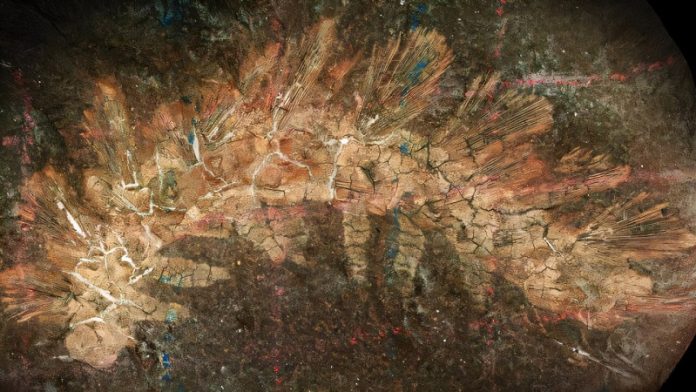
For over a century, a tiny fossil at Harvard’s Museum of Comparative Zoology was wrongly believed to be a caterpillar—or maybe a worm, or a millipede, or even a marine creature.
But thanks to a fresh look and modern technology, scientists have now revealed its true identity: the oldest known nonmarine lobopodian, a long-extinct, worm-like animal with legs that helps connect the evolutionary dots between ancient worms and today’s arthropods like insects and crustaceans.
Originally described in 1865 and named Palaeocampa anthrax, this fossil had been confusing scientists for decades.
It wasn’t until Richard Knecht, a former Harvard Ph.D. student and now a postdoctoral researcher at the University of Michigan, reexamined it that its secrets began to unfold.
While studying fossil millipedes in Harvard’s collection, Knecht noticed something odd: this “millipede” had legs on every body segment, which didn’t match known features of caterpillars or worms. Instead, it looked a lot like a lobopodian.
Lobopodians are soft-bodied animals that lived mostly in the ocean hundreds of millions of years ago.
Famous examples, such as Hallucigenia, come from marine fossil sites like Canada’s Burgess Shale and were thought to be ocean dwellers only.
But Palaeocampa changes that view.
The new study, published in Communications Biology, identifies it as the first known lobopodian from a freshwater environment—and also the youngest ever found, dating back nearly 50 million years before the famous Cambrian species.
To confirm the discovery, Knecht and his team analyzed 43 fossils from two rich fossil sites: Mazon Creek in the U.S. and Montceau-les-Mines in France.
They used high-powered tools like scanning electron microscopes and infrared spectroscopy to uncover stunning details.
One of the most striking features was a dense coat of nearly 1,000 tiny spines covering its body. Tests revealed that these spines may have released toxins, acting as a defense mechanism against predators in its swampy, freshwater home.
The animal itself was only about four centimeters long, blind, and leggy, with ten pairs of legs and no claws. Its closest known relative, Hadranax, lived about 200 million years earlier in the seas of ancient Greenland. Unlike Palaeocampa, Hadranax had no armor and likely relied on long feeler-like appendages to explore the ocean floor. The discovery of Palaeocampa not only adds a rare example of a freshwater lobopodian but also proves that some of these animals made the leap from the sea to land or freshwater habitats.
Importantly, this find also helps settle a long-standing mystery about the Montceau-les-Mines site in France. It had been debated whether it was once underwater, but Palaeocampa’s presence confirms it was a freshwater or land environment—hundreds of kilometers from the sea.
The fossil’s long-overlooked status is a reminder of the hidden value inside museum collections. Knecht found the specimen sitting just feet from the office of the late Stephen Jay Gould, the famous evolutionary biologist who helped make Burgess Shale fossils famous. “It was literally hiding in plain sight,” Knecht said.
The discovery opens new questions about how many more of these ancient creatures might be hiding in museum drawers, misidentified or forgotten. It also highlights how rare and precious soft-bodied fossils are—especially from the Carboniferous period, when Palaeocampa lived.
In the end, this tiny, spiny creature has rewritten a small but important part of evolutionary history, showing that sometimes, the biggest discoveries are the ones waiting quietly in the background.



